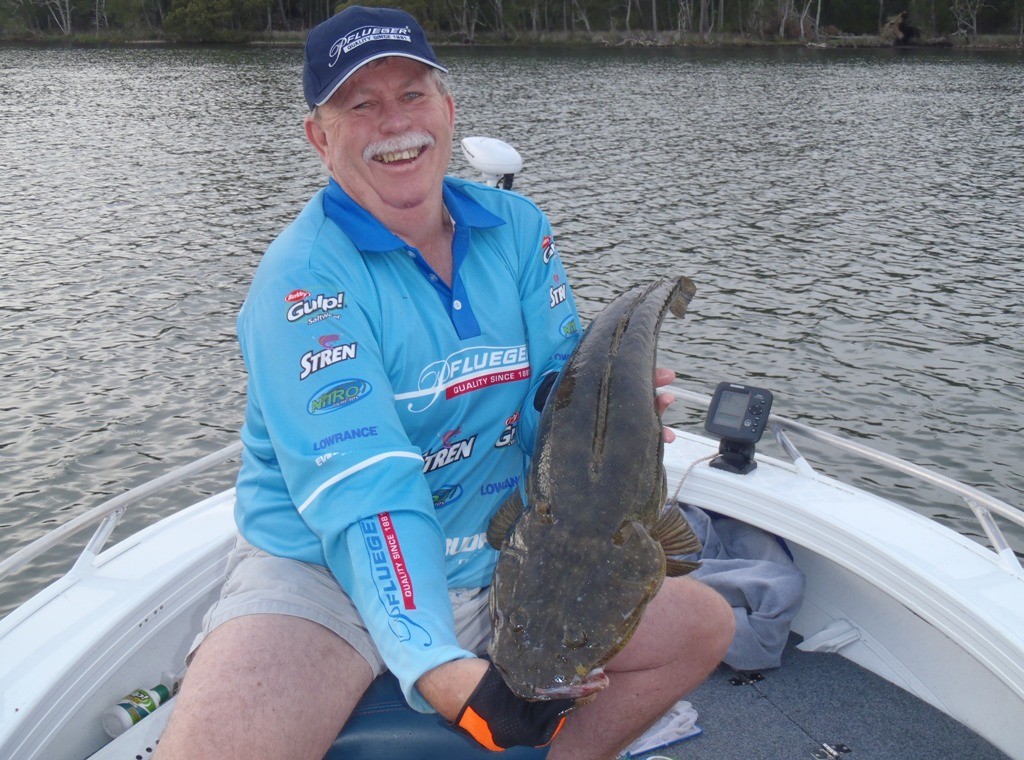How to target dusky flathead with soft plastics
by Gary Brown on 8 Jan 2013

The author with a 94cm dusky flathead which was caught while fishing in St Georges Basin on the NSW south coast Gary Brown
I am still amazed at the amount of anglers who still say that the dusky flathead is not worth catching, because they don’t put up a fight and it’s like pulling in a wet sock and the only way you can catch dusky flathead is by drifting with a bait out the back for hours on end waiting for a dusky flathead to jump on the pasting bait.
Now don’t get me wrong I have nothing against drifting for dusky flathead using bait. I still do it, but I would like to say is that a very high percentage of my dusky flathead now days are caught while using soft plastics.
There are literally hundreds of different overseas and Australian manufactures out there that are supplying soft plastics into tackle shops in Australia. So many in fact that the humble ball jig head has taken on a number of different shapes and sizes to accommodate, not only the different types of plastics, but also the many different types of fish species you can catch with them.
Okay, so what do I think that makes an excellent jig head that I would use for chasing flathead with soft plastics?
- They have to have a chemically sharpen point that will penetrate easily into the fishes mouth.
- There has to be some kind of a keeper device just below the head of the jig to help hold the soft plastic on the shaft of the jig.
- The wire has to be strong enough so that it doesn’t straighten out.
- The shape of the jig head needs to suit the type of soft plastic that you are using.
What I have also found that the action of the jig heads as it is worked through the water will impart more action to the plastic itself. When chasing dusky flathead with jig heads and soft plastic I have found that I will use two different techniques.
- The single or double jerk
- The hopping method
- The Shore-based hopping method
I have found that to be successful in catching dusky flathead with soft plastics when fishing off the shore you will need to be pro-active, rather than non-active. In other words, if you sit on your backside (non-active) and wait for the fish to come to you while casting, you may get a fish or two. But if you change and work hard at targeting the fish (pro-active) your catch rate will increase tenfold.
When using the larger Shads (four to six inch) in water that is running fairly quickly and the depth of water is between three to five metres I will select the Berkley Nitro Saltwater Pro jig heads1/4 and 3/8 oz jig heads. The extra weight will enable me to cast that much further, while at the same time get it down quicker to the bottom where the dusky flathead are laying in ambush. You could also use the 1/4 once No 1, 1/0, 2/0, 3/0 and 4/0 or you could go heavier and use the 3/8 once 2/0 and 4/0.
To help the soft plastic to get down where the flathead are, I make sure that I cast it up current, as this will give it enough time to hit the bottom. You will know when the soft plastic has hit the bottom by watching the GSP line go limp. When this happens all you need to do is wind in the slack line and lift the rod tip up to about 60 degrees off the water’s surface. This will cause the soft plastic to rise slowly off the bottom. Then lower the rod tip back down and wind up the slack line. Keep on repeating this process over and over again until it reaches the area where the sandy bottom meets the weed bed or shoreline.
The single or double jerk while drifting in Shallow waters over a combination of sand and weed beds.
By shallow waters I mean the depth of water needs to be no deeper that say 2.5m and as shallow as your boat will go. When fishing in this depth of water I prefer to use the No 2, 1/8 once or 1/0, 1/4 oz Jig heads in the 1/4 once No 1, 1/0, 2/0, 3/0 and 4/0. The type of plastic could be a shad, double or single tailed grub or stick baits.
The single or double jerk is where you cast out the jig head and soft plastic in the same direction as the boat is drifting. You then allow it to hit the bottom. Remember to wind up that slack line, while at the same time pointing the rod tip down to the surface of the water. Instead of slowly lift the rod tip upwards; you either whip the rod in a single or double action.
This will cause the soft plastic to rocket off the bottom and hopefully attract the attention of a flathead. Many of the takes will be as the soft plastic flutters back down to the bottom. The next time that you repeat this process you will usually find that the flathead has it already in its mouth.
The way that you know whether a dusky flathead has taken the soft plastics is there may be the slightest straitening of the GSP line on the top of the water as the fish has come off the bottom and taken the lure as it is fluttering back down to the bottom. Or you may feel and extra weight on the line as you quickly lift the rod tip upwards.
If you want to link to this article then please use this URL: www.sail-world.com/105391